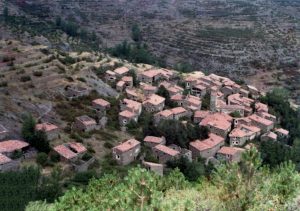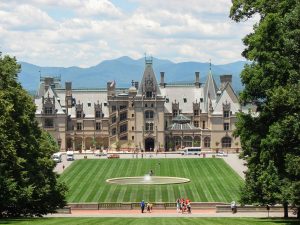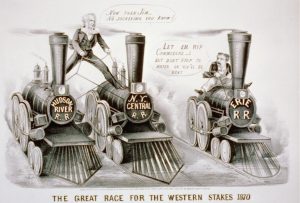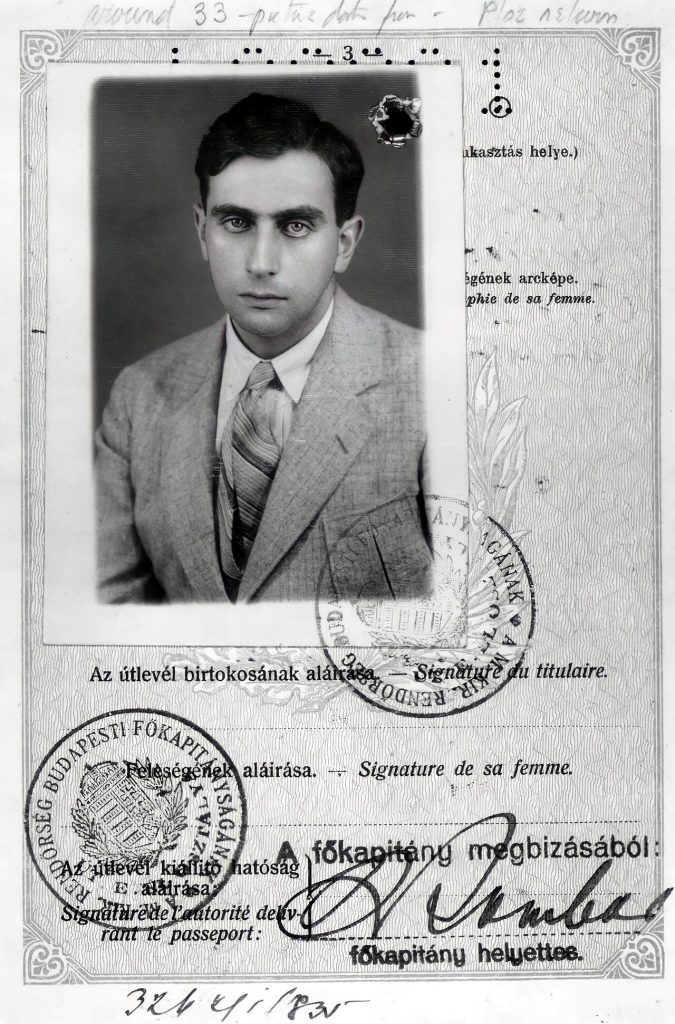
Teller carried the Hungarian passport when he entered the United States in 1935 (Wiki Image).
Edward Teller Quotes
Edward Teller, often called the “Father of the Hydrogen Bomb,” was a complex and controversial figure known for his strong opinions on science, national security, and nuclear weapons. His quotes often reflect his conviction about the necessity of scientific and technological advancement for national defense, as well as his views on the Cold War.
Here are some notable quotes attributed to Edward Teller:
- “The greatest good for the greatest number is not always achieved by the simplest method.”
- Context: Reflects his belief that complex and sometimes morally challenging scientific endeavors (like nuclear weapons) might be necessary for the perceived greater good.
- “The world is what it is, not what we’d like it to be.”
- Context: A pragmatic and often stark view on geopolitical realities, particularly in the context of the Cold War and the arms race.
- “Science is fun. Science is exciting. Science is wonder. And science is about what you believe.”
- Context: Expresses his passion for science itself, highlighting its intellectual and exploratory aspects.
- “The most important difference between a good scientist and a great one is imagination.”
- Context: Emphasizes the importance of creativity and visionary thinking in achieving scientific breakthroughs.
- “The world is a dangerous place, not because of those who do evil, but because of those who look on and do nothing.”
- Context: A strong moral and political statement, often interpreted as a call to action against perceived threats, particularly related to national defense.
- “There is no way to abolish nuclear weapons, but there is a way to make them useless: that is to make them obsolete.”
- Context: Reflects his concept of “peace through strength” and the idea that continued scientific advancement in defense could deter war. This ties into his advocacy for missile defense systems (“Star Wars”).
- “The only purpose of atomic bombs is to keep the peace.”
- Context: A justification often used by proponents of nuclear deterrence.
- “In the 20th century, we learned how to kill. In the 21st century, we are learning how to live without killing.”
- Context: Expresses a hope for the future, perhaps contrasting it with the grim realities of the nuclear age he helped shape.
- “A truly creative scientist is more interested in what is not known than in what is known.”
- Context: Another quote highlighting his value of curiosity and exploration in science.
- “Everything we know about the world we learn through measurement.”
- Context: Emphasizes empiricism and the importance of quantitative data in scientific understanding.
Teller’s quotes often provide a glimpse into the mind of a scientist deeply involved in the most significant and controversial technological developments of the 20th century, wrestling with their implications for humanity.
Edward Teller YouTube Video
- ‘Father of hydrogen bomb’ Dr. Edward Teller interview 1963 by CBS 8 San Diego: 93,268 views (http://www.youtube.com/watch?v=Yroh8pJ21YE)
- The Scientist Who Nearly Destroyed the World by Newsthink: 72,190 views (http://www.youtube.com/watch?v=fTIbSVEVVY0)
- Day at Night: Edward Teller, nuclear physicist by CUNY TV: 103,468 views (http://www.youtube.com/watch?v=z8uZKs0Pv68)
- Father of the Hydrogen Bomb. Edward Teller! #documentary #history by Wild Story: 19,646 views (http://www.youtube.com/watch?v=iaY1sYF5byY)
- Hydrogen bombs are TOO BIG to be worth making by Dwarkesh Patel: 3,051,124 views (http://www.youtube.com/watch?v=odDB-ZX4pkk)
Edward Teller as a young man.
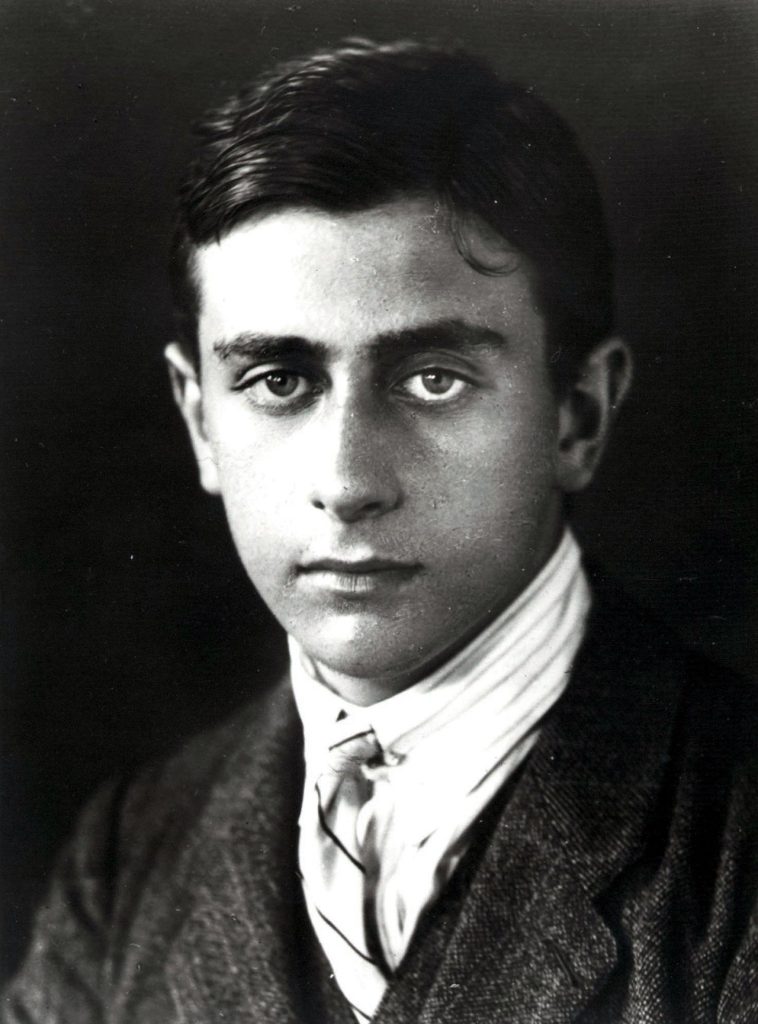
Teller in his youth (Wiki Image).
Edward Teller was born in Hungary in 1908. He was a brilliant physicist who played a key role in the development of the hydrogen bomb. He was also a controversial figure due to his strong support for nuclear weapons.
Teller was a young man when he first became interested in physics. He studied at the University of Budapest, where he was a student of Leo Szilard. In 1933, Teller fled Hungary to escape the rise of fascism. He settled in the United States, where he continued his studies at Princeton University and the University of California, Berkeley.
Teller was a member of the Manhattan Project, the secret U.S. program to develop the atomic bomb. He played a key role in the development of the Teller-Ulam design, which is the basis for all modern thermonuclear weapons.
After the war, Teller continued to work on nuclear weapons. He was a strong advocate for the development of the hydrogen bomb, and he helped to lead the project to develop the first hydrogen bomb.
Teller was a controversial figure due to his strong support for nuclear weapons. He was criticized by some for his role in the development of the hydrogen bomb, and he was accused of being a warmonger.
Despite the controversy, Teller was a respected scientist. He was a member of the National Academy of Sciences, and he received numerous awards for his work in physics. He died in 2003 at the age of 95.
Edward Teller of Manhattan Project.
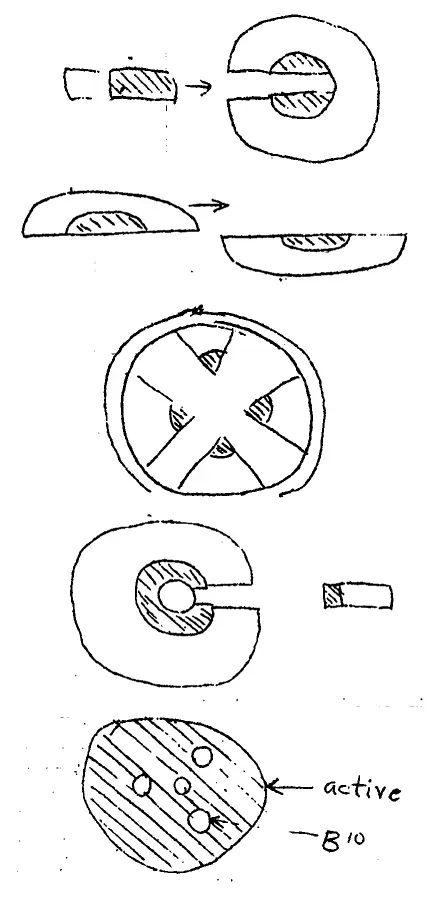
Different fission bomb assembly methods were explored during the July 1942 conference (Wiki Image).
Edward Teller was one of the leading scientists involved in the Manhattan Project, the United States’ effort to develop the atomic bomb during World War II. He was a strong advocate for the development of the hydrogen bomb, and he played a key role in its development.
Teller was born in Budapest, Hungary, in 1908. He studied physics at the University of Budapest and the University of Leipzig. In 1930, he moved to the United States to work at the University of California, Berkeley.
Teller joined the Manhattan Project in 1943. He was initially assigned to the Theoretical Division at Los Alamos National Laboratory, where he worked on the development of the implosion method for detonating an atomic bomb. He also worked on the development of the hydrogen bomb, which was first tested in 1952.
Teller was a controversial figure. He was known for his strong advocacy of nuclear weapons, and he was also a critic of arms control agreements. He was a member of the so-called “Hydrogen Bomb Lobby,” which argued that the United States should develop a hydrogen bomb as soon as possible.
Teller’s legacy is complex. He is credited with playing a key role in the development of the hydrogen bomb, but he is also criticized for his advocacy of nuclear weapons and his opposition to arms control agreements. However, there is no doubt that Teller was a brilliant physicist and a visionary thinker, and his work had a profound impact on the course of history.
Here are some of Teller’s contributions to the Manhattan Project:
- He was one of the first scientists to propose the use of an implosion method to detonate an atomic bomb.
- He worked on the development of the first hydrogen bomb.
- He helped to develop the Teller-Ulam design, which is the basis for all modern hydrogen bombs.
Teller’s work on the Manhattan Project had a profound impact on the course of history. The atomic bombs that were developed during the Manhattan Project were used to end World War II, and they also ushered in the nuclear age. Teller’s work on the hydrogen bomb also had a significant impact on the Cold War. The development of the hydrogen bomb led to an arms race between the United States and the Soviet Union, and it also increased the risk of nuclear war.
Teller’s legacy is complex and controversial. He is credited with playing a key role in the development of some of the most destructive weapons ever created, but he is also a brilliant physicist and visionary thinker. His work has had a profound impact on the course of history, and it will continue to be debated for many years to come.
Edward Teller versus Robert Oppenheimer.
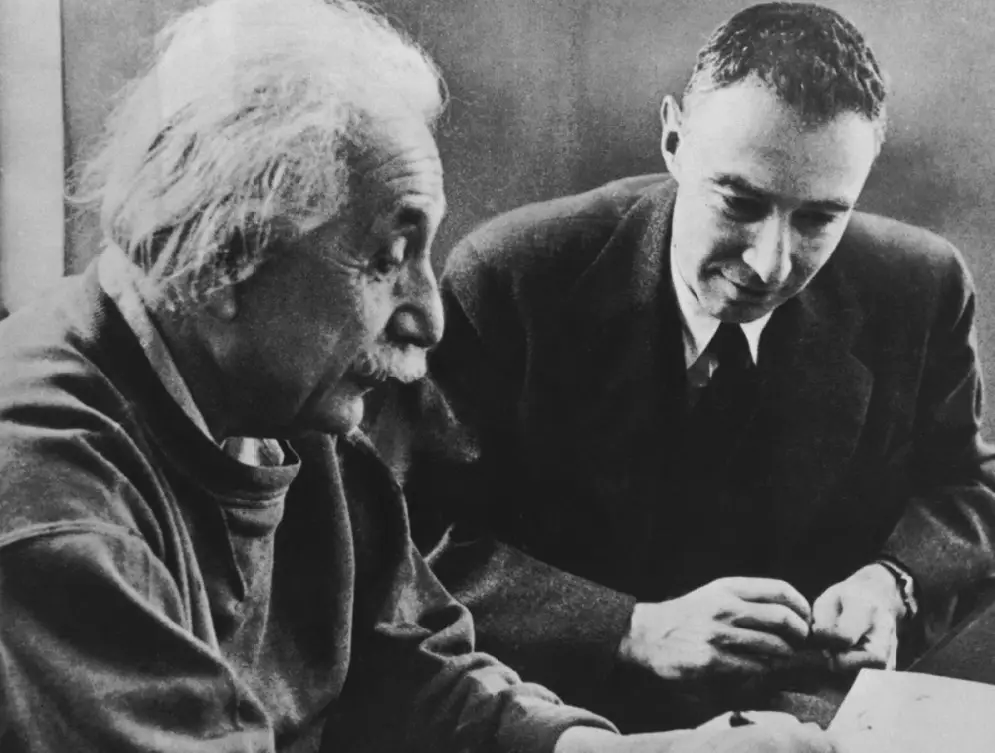
Physicists Albert Einstein and Oppenheimer conferring circa 1950 (Wiki Image).
Edward Teller and Robert Oppenheimer were two of the most important figures in the development of the atomic bomb. They were both brilliant physicists, but they had very different personalities and views on the use of nuclear weapons.
Teller was a Hungarian-American physicist who was known for his fiery temper and his intense commitment to the development of nuclear weapons. He was a strong advocate for the hydrogen bomb, and he was one of the scientists who worked on the Manhattan Project.
Oppenheimer was an American physicist who was known for his calm and rational demeanor. He was the scientific director of the Manhattan Project, and he was responsible for overseeing the development of the atomic bomb. He was also a strong advocate for nuclear non-proliferation.
The two men had a very public falling out in the 1950s when Teller testified against Oppenheimer in his security clearance hearing. Teller accused Oppenheimer of being a security risk, and he argued that Oppenheimer was not fit to work on nuclear weapons.
The Oppenheimer-Teller controversy was a major event in the history of the atomic bomb, and it highlighted the different views on the use of nuclear weapons. Teller believed that nuclear weapons were a necessary evil, while Oppenheimer believed that they were a threat to humanity.
The two men’s legacy is still debated today. Teller is often seen as a hero by those who believe that nuclear weapons are necessary for national security. Oppenheimer is often seen as a martyr by those who believe that nuclear weapons should be banned.
Here is a table that summarizes the differences between Teller and Oppenheimer:
| Characteristic | Teller | Oppenheimer |
| Nationality | Hungarian-American | American |
| Personality | Fiery and intense | Calm and rational |
| Views on nuclear weapons | Believed that nuclear weapons were a necessary evil | Believed that nuclear weapons were a threat to humanity |
| Role in the Manhattan Project | Worked on the development of the hydrogen bomb | Scientific director of the Manhattan Project |
| Legacy | Seen as a hero by those who believe that nuclear weapons are necessary for national security | Seen as a martyr by those who believe that nuclear weapons should be banned |
Truman and Eisenhower met Teller.
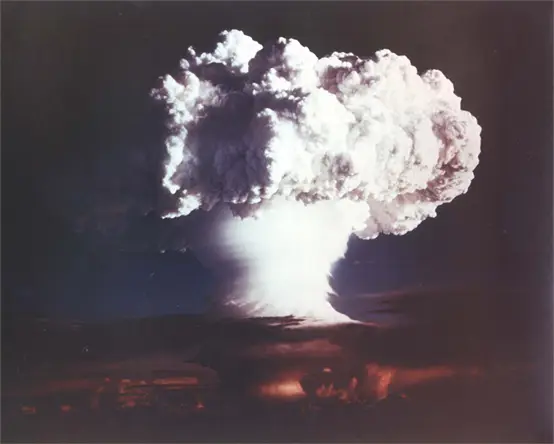
The 10.4 megatons Mt “Ivy Mike” shot of 1952 appeared to vindicate Teller’s long-time advocacy for the hydrogen bomb (Wiki Image).
Edward Teller had a close relationship with both President Harry Truman and President Dwight D. Eisenhower. He was a key advisor to both presidents on nuclear weapons policy, and he played a major role in the development of the hydrogen bomb.
Teller met Truman in 1945, shortly after the Trinity test, and he quickly became a trusted advisor to the president on nuclear weapons matters. He urged Truman to develop a hydrogen bomb, and he was instrumental in convincing the president to approve the crash program that led to the development of the weapon.
Teller’s relationship with Eisenhower was also close. Eisenhower strongly supported nuclear weapons, and he shared Teller’s belief that the United States needed to maintain a strong nuclear deterrent. Teller served as an advisor to Eisenhower on nuclear weapons policy throughout his presidency, and he played a key role in the development of the new generation of nuclear weapons that were deployed during the Eisenhower years.
Teller’s relationship with Truman and Eisenhower was based on their shared belief in the importance of nuclear weapons. Both presidents saw nuclear weapons as a powerful deterrent against Soviet aggression, and they were willing to invest heavily in the development of new nuclear weapons systems. Teller’s expertise in nuclear physics made him a valuable asset to both presidents, and he played a major role in shaping US nuclear weapons policy during the Cold War.
Here are some of the specific ways in which Teller related to Truman and Eisenhower:
- He advised Truman on the development of the hydrogen bomb.
- He served as an advisor to Eisenhower on nuclear weapons policy throughout his presidency.
- He played a crucial role in developing the new generation of nuclear weapons deployed during the Eisenhower years.
- He shared Truman’s and Eisenhower’s belief in the importance of nuclear weapons.
- He was a valuable asset to both presidents because of his expertise in nuclear physics.
- He helped to shape US nuclear weapons policy during the Cold War.
Truman and Eisenhower met Oppenheimer.
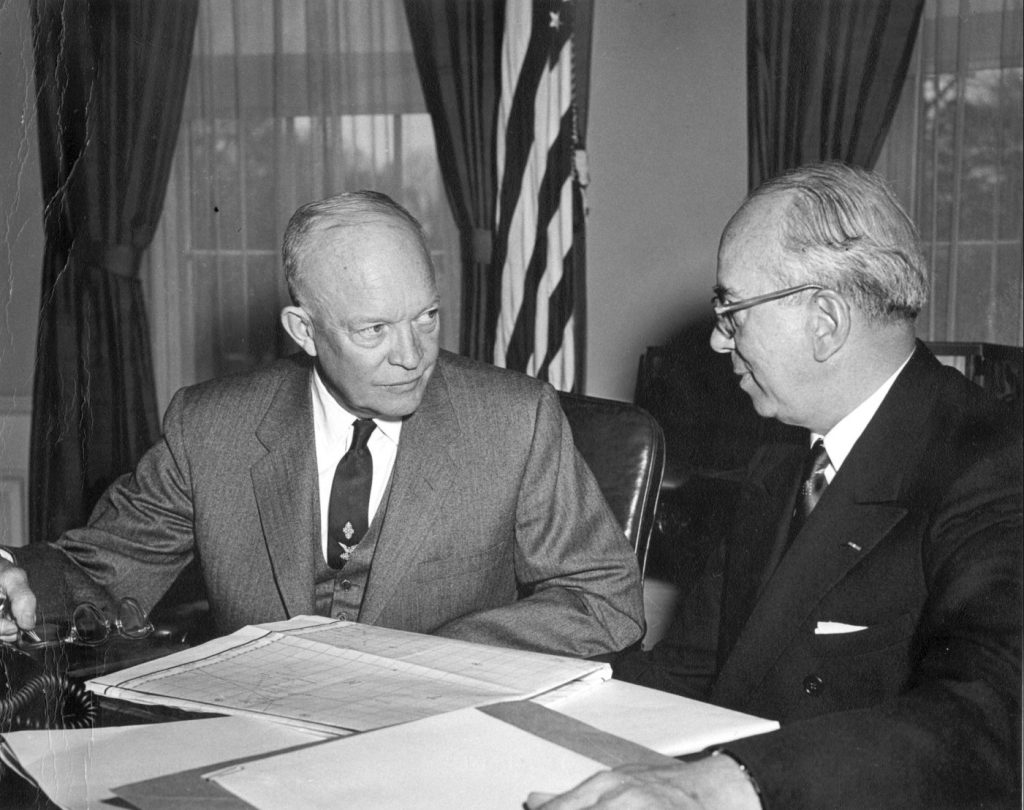
President Dwight D. Eisenhower received a report from Lewis L. Strauss, Chairman of the Atomic Energy Commission, on Operation Castle hydrogen bomb tests in the Pacific, on March 30, 1954. Strauss pressed for revoking Oppenheimer’s security clearance (Wiki Image).
Yes, President Harry S. Truman and President Dwight D. Eisenhower both met with J. Robert Oppenheimer, the scientific director of the Manhattan Project.
Truman met with Oppenheimer on multiple occasions, including shortly after the successful test of the first atomic bomb in New Mexico in April 1945. Eisenhower met with Oppenheimer on two occasions, in 1953 and 1954.
The meetings between Truman and Oppenheimer were generally cordial, but the meetings between Eisenhower and Oppenheimer were more strained. Eisenhower was concerned about Oppenheimer’s increasing opposition to the hydrogen bomb, and he ultimately supported the decision to strip Oppenheimer of his security clearance in 1954.
Despite their differences, Truman, Eisenhower, and Oppenheimer all respected each other’s intelligence and scientific knowledge.
Here are some of the key events that took place during the meetings between Truman, Eisenhower, and Oppenheimer:
- April 25, 1945: Truman meets with Oppenheimer in the Oval Office to discuss the successful test of the first atomic bomb.
- July 25, 1945: Truman meets with Oppenheimer and other scientists to discuss the use of the atomic bomb against Japan.
- December 31, 1953: Eisenhower meets with Oppenheimer at the White House to discuss the hydrogen bomb.
- April 29, 1954: Eisenhower meets with Oppenheimer at the Pentagon to discuss his security clearance.
The meetings between Truman, Eisenhower, and Oppenheimer were significant events in the history of nuclear weapons policy. They provide insights into the decision-making process that led to the use of the atomic bomb against Japan, and they also shed light on the debate over the development of the hydrogen bomb.
Edward Teller started the Lawrence Livermore National Laboratory.
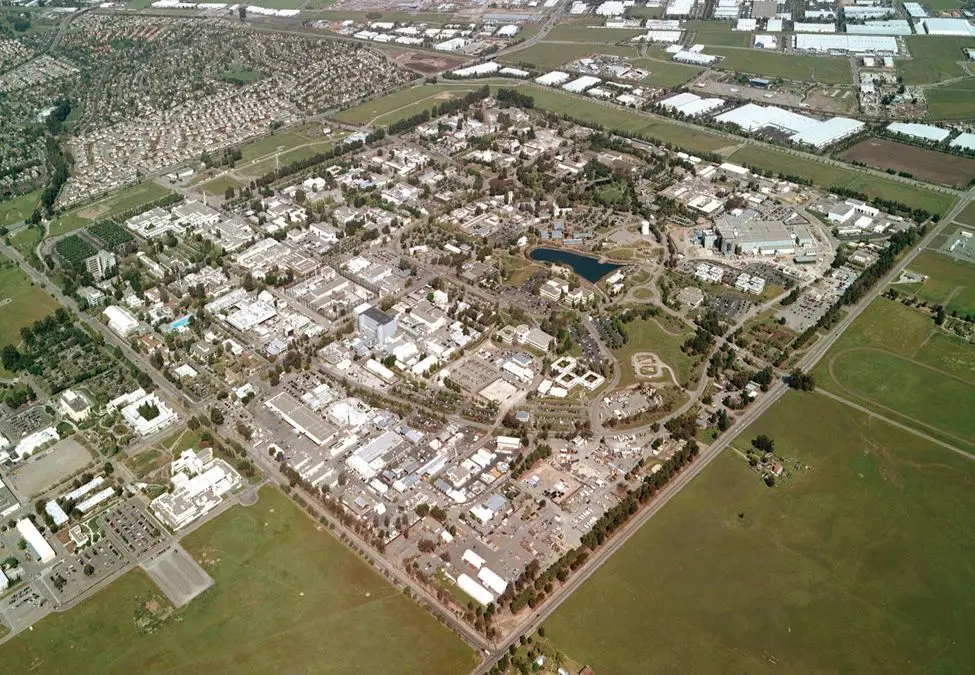
Aerial view of Lawrence Livermore National Laboratory (Wiki Image).
Teller was one of the driving forces behind the founding of LLNL, which was established in 1952 as a second weapons laboratory to complement Los Alamos National Laboratory. Teller served as the laboratory’s second director from 1958 to 1960 and remained prominent at LLNL for many years afterward.
Teller’s work at LLNL focused on the development of nuclear weapons, including the hydrogen bomb. He was also a strong advocate for using nuclear power for peaceful purposes, and he helped develop the Plowshare Program, which explored nuclear explosions for civilian projects such as creating canals and extracting minerals.
Teller’s legacy at LLNL is complex and controversial. He is credited with playing a key role in developing the hydrogen bomb, but he is also criticized for his advocacy of nuclear weapons and opposition to arms control agreements. However, there is no doubt that Teller was a brilliant physicist and a visionary thinker, and his work at LLNL profoundly impacted the course of history.
Here are some additional details about Teller’s involvement with LLNL:
- He was one of the first scientists recruited to LLNL and helped shape the laboratory’s mission and priorities.
- He was instrumental in developing the laboratory’s first nuclear weapons, including the hydrogen bomb.
- He was a strong advocate for using nuclear power for peaceful purposes, and he helped develop the Plowshare Program.
- He served as the laboratory’s director from 1958 to 1960.
- He remained a prominent figure at LLNL for many years afterward.
Edward Teller and their engineers miniaturized the hydrogen bomb.
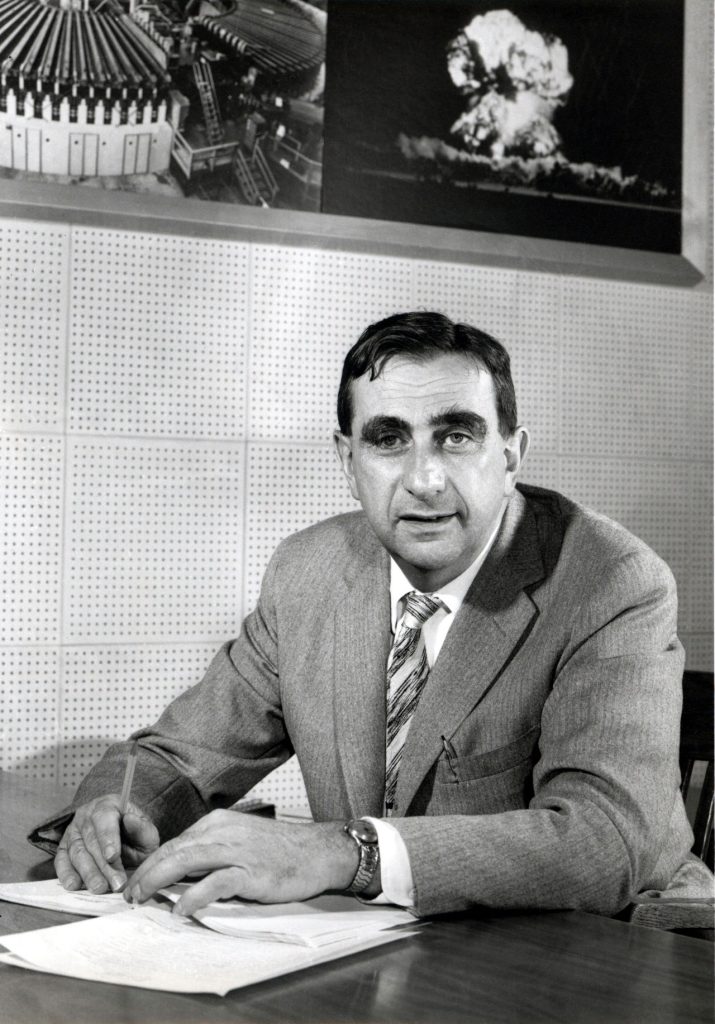
Teller in 1958 (Wiki Image).
Edward Teller was a key figure in developing miniaturized hydrogen bombs, and he worked with a team of engineers to make it possible. The team included Stanislaw Ulam, Harold Brown, and John von Neumann.
The miniaturization of the hydrogen bomb was a complex and challenging task. The team had to develop new materials and methods that would allow them to create a more powerful explosion in a smaller package. They also had to develop new strategies for delivering hydrogen bombs, such as cruise missiles and air-launched ballistic missiles.
The team’s efforts were successful, and they could create hydrogen bombs that were small enough to be carried by aircraft. These developments significantly impacted the Cold War, making it possible for the United States and the Soviet Union to deploy hydrogen bombs on a much larger scale.
Here are some of the key contributions that Edward Teller and his team made to the miniaturization of the hydrogen bomb:
- They developed new materials that were lighter and stronger than the materials used in the first hydrogen bombs.
- They developed new methods for compressing the fuel in a hydrogen bomb, which made it possible to create a more powerful explosion in a smaller package.
- They developed new methods for delivering hydrogen bombs, such as cruise missiles and air-launched ballistic missiles.
The miniaturization of the hydrogen bomb was a major technological achievement, and it had a profound impact on the course of the Cold War. Edward Teller and his team played a key role in this achievement, and their work continues to significantly impact the world today.
Edward Teller of Admiral Rickover.
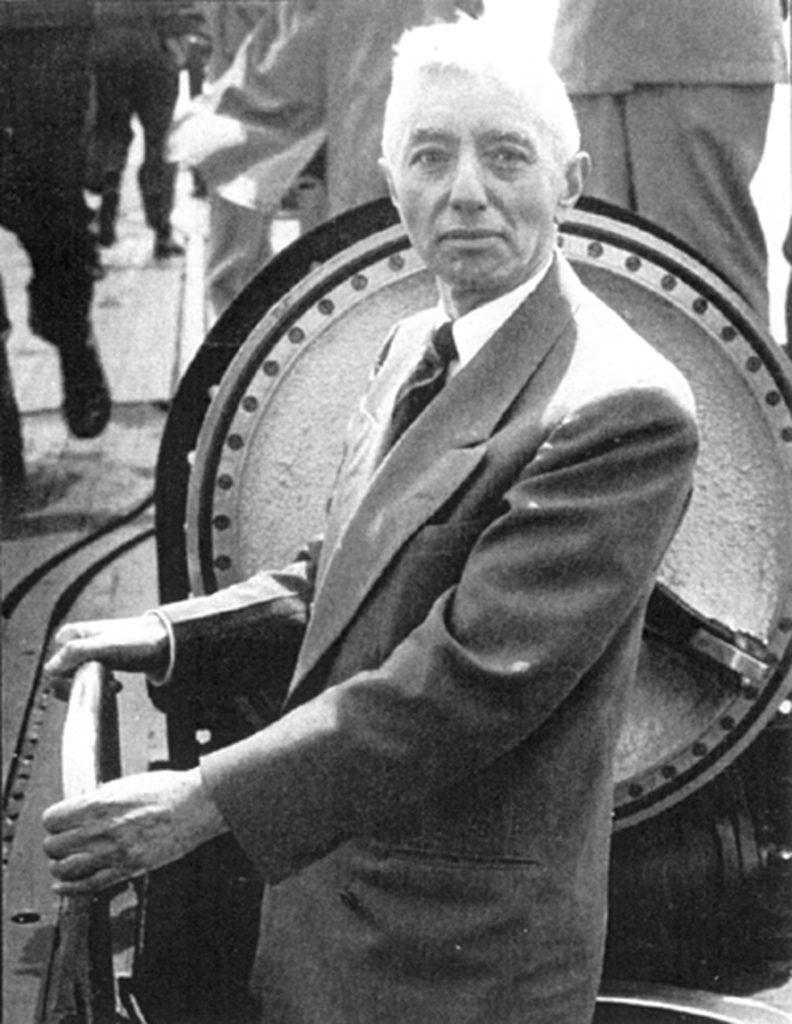
Admiral Rickover aboard USS Nautilus, the world’s first nuclear-powered vessel: “I did not recruit extraordinary people. I recruited people who had extraordinary potential—and then I trained them.” (Wiki Image)
Edward Teller and Hyman George Rickover were both physicists who played a significant role in the development of nuclear weapons and nuclear power in the United States. Teller was a Hungarian-American physicist who was born in Budapest, Hungary, in 1908. Rickover was an American naval engineer who was born in Chicago, Illinois, in 1900.
Teller and Rickover met in 1942 when they were both working on the Manhattan Project, the United States’ effort to develop the atomic bomb during World War II. Teller was a member of the Theoretical Division at Los Alamos National Laboratory, while Rickover was the head of the Navy’s nuclear submarine program.
Teller and Rickover had a complex relationship. They were both brilliant physicists, but they had very different personalities. Teller was a charismatic and outspoken advocate for nuclear weapons, while Rickover was a more reserved and technical engineer.
Despite their differences, Teller and Rickover had mutual respect for each other’s work. They both believed that nuclear weapons were essential to the security of the United States, and they both worked tirelessly to develop and improve these weapons.
Teller and Rickover also had a significant impact on the development of nuclear power. Teller was a strong advocate for the use of nuclear power for peaceful purposes, and he helped to found the Lawrence Livermore National Laboratory, which is one of the leading research centers for nuclear energy. Rickover was the driving force behind the development of the nuclear submarine, which was the first practical application of nuclear power.
Teller and Rickover were both controversial figures. Teller was criticized for his advocacy of nuclear weapons, while Rickover was criticized for his authoritarian management style. However, there is no doubt that both men made significant contributions to the development of nuclear weapons and nuclear power.
Their work has had a profound impact on the course of history, and it will continue to be debated for many years to come.
Edward Teller of Project Plowshare.
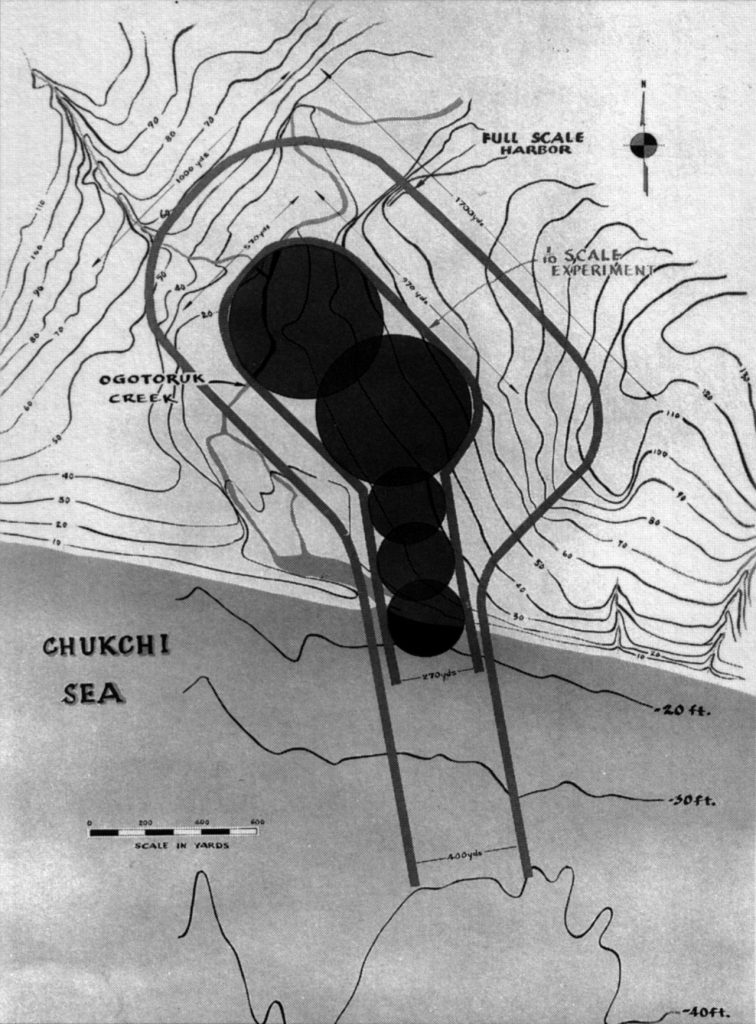
One of the Chariot schemes involved chaining five thermonuclear devices to create an artificial harbor (Cape Thompson, Alaska) (Wiki Image).
Edward Teller was a strong advocate for the use of nuclear weapons for peaceful purposes. He was one of the architects of Project Plowshare, a program that explored the use of nuclear explosions for civilian projects such as creating canals, excavating harbors, and extracting minerals.
Project Plowshare was launched in 1957 by the Atomic Energy Commission (AEC). Teller was a member of the AEC’s Plowshare Task Force, which was responsible for developing and implementing the program.
The first Plowshare project was Project Gnome, which was a test of the feasibility of using nuclear explosions to create a harbor in Alaska. The Gnome test was successful, and it led to a number of other Plowshare projects, including Project Sedan, which was a test of the feasibility of using nuclear explosions to excavate a large crater.
Project Plowshare was controversial. Some people argued that the use of nuclear explosions for civilian projects was too dangerous and that it could lead to the proliferation of nuclear weapons. Others argued that the benefits of Plowshare outweighed the risks and that the program could help to solve some of the world’s most pressing problems.
Project Plowshare was eventually abandoned in the 1970s. However, the program’s legacy continues to be debated. Some people believe that Plowshare was a visionary program that could have helped to solve some of the world’s most pressing problems. Others believe that Plowshare was a dangerous program that could have led to the proliferation of nuclear weapons.
Edward Teller’s role in Project Plowshare is complex. He was a strong advocate for the program, and he played a key role in its development. However, he was also aware of the risks of the program, and he argued that the benefits outweighed the risks.
Teller’s legacy on Project Plowshare is mixed. He is credited with being a visionary thinker who saw the potential of nuclear explosions for peaceful purposes. However, he is also criticized for his advocacy of a program that was seen by some as dangerous.
Ultimately, the legacy of Project Plowshare is still being debated. However, there is no doubt that Edward Teller played a key role in the program, and his ideas continue to be influential today.
Edward Teller of Supercomputing.
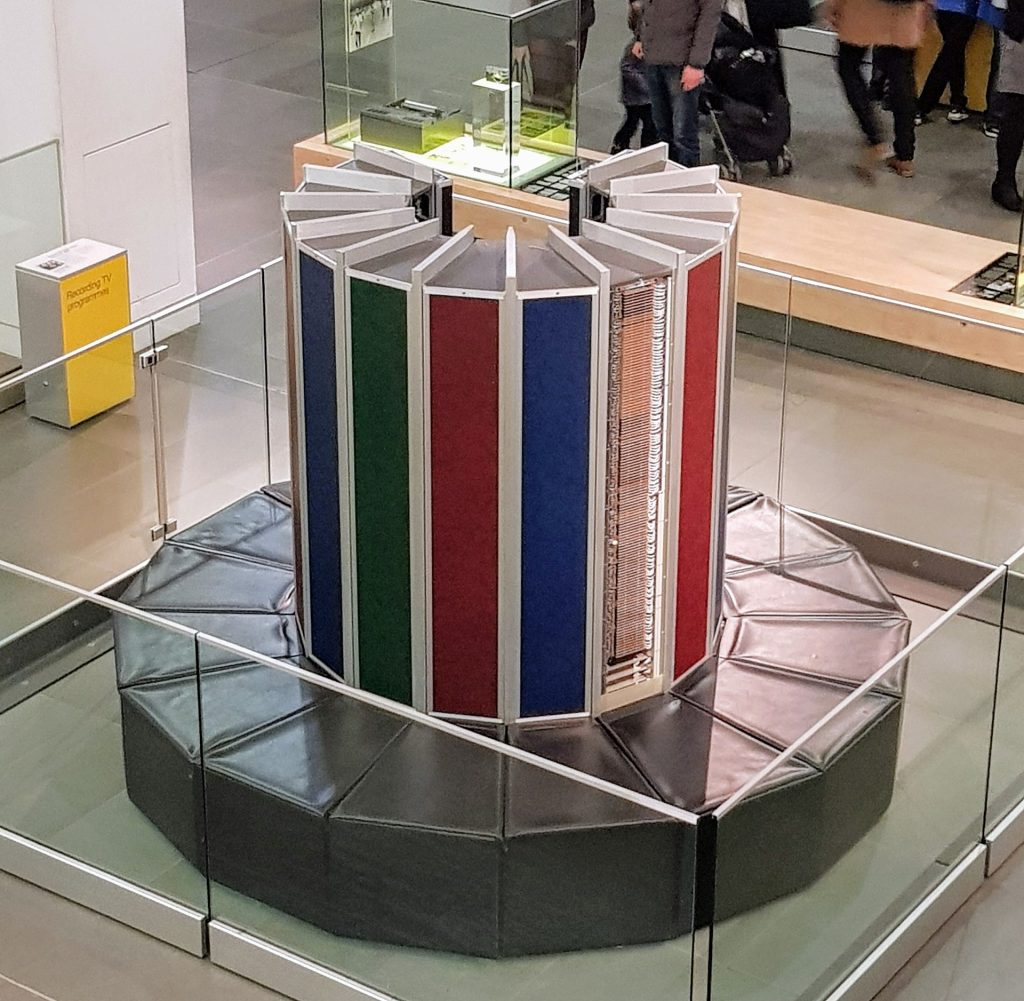
Cray-1 (1975) (Wiki Image).
Edward Teller was a strong advocate for the development of supercomputing. He believed that supercomputing could be used to solve some of the world’s most pressing problems, such as climate change and nuclear fusion.
Teller was a member of the Lawrence Livermore National Laboratory, which is one of the leading supercomputing centers in the world. He helped to secure funding for the laboratory’s supercomputing program, and he also worked to promote the use of supercomputing in other research institutions.
Teller was also a strong advocate for the development of high-performance computing (HPC). He believed that HPC was essential to the future of science and engineering, and he worked to promote the use of HPC in a number of different fields.
Teller’s work on supercomputing had a significant impact on the course of scientific research. Supercomputing has been used to solve a wide range of problems, including climate modeling, nuclear fusion research, and drug discovery.
Teller’s legacy in supercomputing is complex and controversial. He is credited with being a visionary thinker who saw the potential of supercomputing. However, he is also criticized for his advocacy of a technology that some see as too expensive and technically difficult to be feasible.
Ultimately, the legacy of supercomputing is still being debated. However, there is no doubt that Edward Teller played a key role in the development of technology, and his ideas continue to be influential today.
Here are some of the key contributions that Edward Teller made to the development of supercomputing:
- He was one of the first scientists to see the potential of supercomputing.
- He helped to secure funding for the development of supercomputing.
- He worked to promote the use of supercomputing in other research institutions.
- He advocated for the development of high-performance computing (HPC).
Teller’s work on supercomputing had a significant impact on the course of scientific research. Supercomputing has been used to solve a wide range of problems, including climate modeling, nuclear fusion research, and drug discovery.
Teller’s legacy in supercomputing is complex and controversial. He is credited with being a visionary thinker who saw the potential of supercomputing. However, he is also criticized for his advocacy of a technology that some see as too expensive and technically difficult to be feasible.
Ultimately, the legacy of supercomputing is still being debated. However, there is no doubt that Edward Teller played a key role in the development of technology, and his ideas continue to be influential today.
Edward Teller, Ronald Reagan, Mikhail Gorbachev, and Strategic Defense.
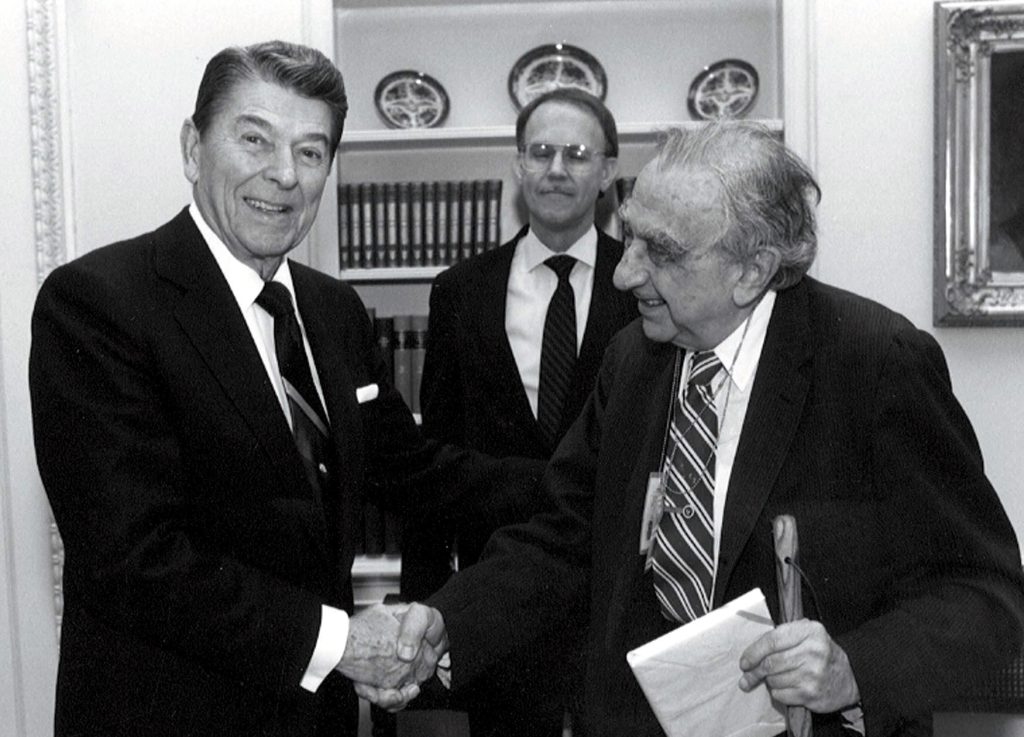
Teller became a major lobbying force of the Strategic Defense Initiative to President Ronald Reagan in the 1980s (Wiki Image).
Edward Teller, Ronald Reagan, and Mikhail Gorbachev were all key figures in the development of Strategic Defense, also known as SDI or “Star Wars.”
Teller was a Hungarian-American physicist who was a strong advocate for SDI. He believed that SDI could protect the United States from a nuclear attack, and he worked tirelessly to promote its development.
Reagan was the 40th president of the United States, and he was a strong supporter of SDI. He announced the Strategic Defense Initiative in a speech to the nation in 1983, and he made it a key priority of his administration.
Gorbachev was the leader of the Soviet Union from 1985 to 1991, and he was initially opposed to SDI. However, he eventually came to see SDI as a way to reduce the risk of nuclear war, and he worked with Reagan to negotiate a treaty to limit the development of SDI.
The Strategic Defense Initiative was a controversial program, and it was never fully implemented. However, it did have a significant impact on the course of the Cold War. It led to a renewed debate about the role of nuclear weapons in the defense of the United States, and it also helped to bring about an end to the Cold War.
Here are some of the key contributions that Edward Teller made to the development of Strategic Defense:
- He was one of the first scientists to propose the use of lasers to shoot down nuclear missiles.
- He helped to develop the concept of a “layered defense system,” which would use a variety of technologies to protect the United States from a nuclear attack.
- He was a strong advocate for the development of space-based weapons, which he believed were essential to the success of SDI.
Teller’s work on Strategic Defense had a significant impact on the course of the Cold War. The SDI program was a major technological challenge, and it helped to stimulate research in a number of areas, including lasers, particle beams, and space-based weapons. The program also led to a renewed debate about the role of nuclear weapons in the defense of the United States.
Teller’s legacy on Strategic Defense is complex and controversial. He is credited with being a visionary thinker who saw the potential of SDI. However, he is also criticized for his advocacy of a program that was seen by some as too expensive and technically difficult to be feasible.
Ultimately, the legacy of Strategic Defense is still being debated. However, there is no doubt that Edward Teller played a key role in the development of the program, and his ideas continue to be influential today.
Edward Teller and John Nuckolls of Laser Fusion Program and break even.
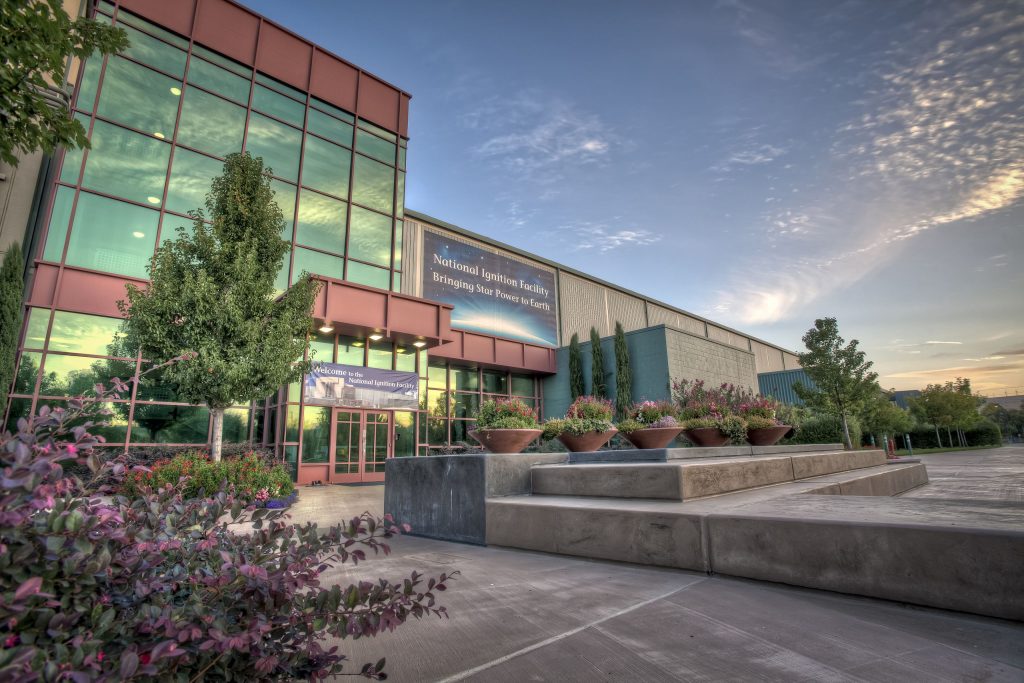
National Ignition Facility(Wiki Image).
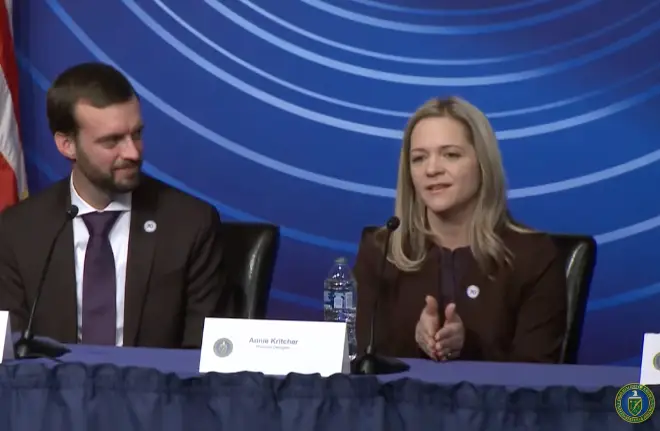
Principal designer Annie Kritcher spoke at the December 13, 2022, press conference announcing the breakeven ignition (Wiki Image).
Edward Teller and John Nuckolls were both physicists who played a significant role in the development of laser fusion. They believed that laser fusion could be used to create a clean and safe source of energy, and they worked tirelessly to promote its development.
One of the key goals of the laser fusion program was to achieve “break even,” which means that the energy released by a fusion reaction would be equal to the energy required to initiate the reaction. This would be a major milestone in the development of laser fusion, as it would demonstrate that the process could be used to generate net energy.
Teller and Nuckolls were instrumental in achieving break even in laser fusion. In 1974, they conducted an experiment at the Lawrence Livermore National Laboratory that produced a fusion yield of 1.25 megajoules. This was the first time that a laser fusion reaction had produced more energy than it required to be initiated.
The achievement of breaking even was a major breakthrough in the development of laser fusion. It showed that the process was feasible, and it paved the way for further research into the development of laser fusion power plants.
However, laser fusion is still a long way from being commercially viable. The energy yield of laser fusion reactions is still relatively low, and the cost of building and operating laser fusion power plants is still very high.
It is still not clear whether laser fusion will ever be able to compete with other sources of energy, such as solar and wind power. However, the work of Teller and Nuckolls has laid the foundation for future research, and their contributions to the field are significant.
Here are some of the key contributions that Edward Teller and John Nuckolls made to the achievement of breaking even in laser fusion:
- They were one of the first scientists to propose the use of lasers to ignite a fusion reaction.
- They helped to develop the concept of a “direct drive” laser fusion system, which is the most promising type of laser fusion system.
- They were strong advocates for the development of high-power lasers, which are essential to the success of laser fusion.
- They helped to design and build the first laser fusion experiments.
- They developed a theoretical understanding of the laser fusion process.
Teller and Nuckolls’ work on laser fusion had a significant impact on the course of energy research. The laser fusion program was a major technological challenge, and it helped to stimulate research in a number of areas, including lasers, plasma physics, and materials science. The program also led to a renewed debate about the future of energy.
Teller and Nuckolls’ legacy on laser fusion is complex and controversial. They are credited with being visionary thinkers who saw the potential of the process. However, they are also criticized for their advocacy of a process that was seen by some as too expensive and technically difficult to be feasible.
Ultimately, the legacy of laser fusion is still being debated. However, there is no doubt that Edward Teller and John Nuckolls played a key role in the development of the process, and their ideas continue to be influential today.

